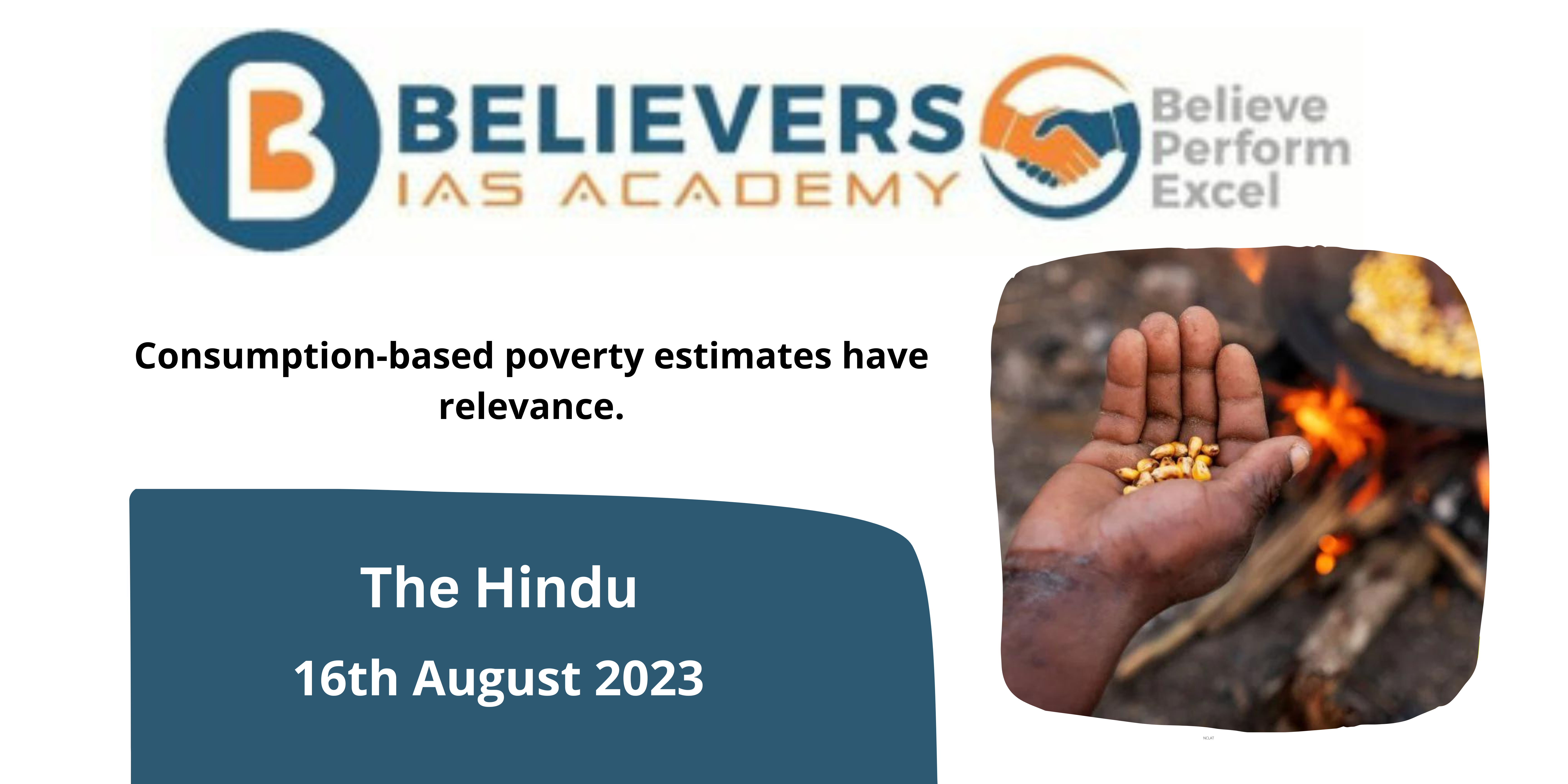Consumption-based poverty estimates have relevance.
Context:
A new report from NITI Aayog regarding multidimensional poverty highlights a drop in the percentage of people in poverty from 25% in 2015-16 to 15% in 2019-21. Approximately 135 million individuals emerged from poverty during this period. The recent Global Multidimensional Poverty Index for 2023, unveiled by the United Nations Development Programme (UNDP) and the Oxford Poverty & Human Development Initiative (OPHI), echoes this trend by showing a decline in the incidence of the multidimensional poverty index from 27.5% in 2015-16 to 16.2% in 2019-21.
Relevance:
GS – 02 (Human Resource)
GS – 03 (Poverty, Growth & Development,Inclusive Growth)
Prelims:
- Multidimensional Poverty Index
- UNDP
- Poverty
- Education
- Health
- Standard of Living.
Mains Question:
- The journey out of poverty is as diverse and intricate as the lives it touches. Comment.
(150 words)
Dimensions of the Article:
- Methodological Considerations and Evolving Trends
- Not a Revelation
- Exploring Dimensions and The Challenge of Indicators
- Aggregation Puzzle and the Balancing Act
- Viewpoint on Multidimensional Issues
- Income’s Role
- Future Prospects
- Crunching Numbers and Data Discrepancies
Methodological Considerations and Evolving Trends:
- Examining the methodology associated with the multidimensional poverty index reveals that consumption-based poverty calculations retain their relevance.
- It’s important to note that these multidimensional figures don’t replace the National Sample Survey (NSS) consumption-based poverty ratios. The two methodologies are distinct.
- The 2018 report of the Global Multidimensional Poverty Index highlights India’s substantial progress in diminishing multidimensional poverty.
- The percentage of multidimensionally impoverished individuals nearly halved between 2005/06 and 2015/16, declining to 27.5%.
- Within a decade, the count of impoverished people in India decreased by over 271 million, a significant achievement.
Not a Revelation:
- However, the above conclusion isn’t groundbreaking, especially when considering the estimates from 2015-16.
- Poverty figures based on consumer expenditure and employing the Tendulkar committee’s approach demonstrate a reduction of 137 million individuals from poverty between 2004-05 and 2011-12, despite a growing population.
- Applying the Rangarajan Committee’s methodology, the decline from 2009-10 to 2011-12 totals 92 million, equating to 46 million per year. These figures actually surpass those of the global MPI.
- Nevertheless, it’s noteworthy that the specific percentages based on Tendulkar and Rangarajan Committee methodologies are lower than the global MPI’s projections.
Exploring Dimensions and The Challenge of Indicators:
- The pursuit of non-income dimensions of poverty stems from the notion that certain ‘capabilities’ might not directly link to the privately purchased goods used to define the current poverty lines.
- Consequently, poverty based on income or consumption diverges from deprivations related to education or health.
- As the Expert Group reviewing the Methodology for Measuring Poverty (2014) emphasized, utilizing multiple indicators introduces challenges of measurability, aggregation, and availability of data.
- For instance, issues arise with the child mortality indicator, which pertains to population groups rather than households.
Aggregation Puzzle and the Balancing Act:
- Aggregating indicators poses another quandary. Some indicators simply can’t be lumped together. For instance, you can’t blend access to safe drinking water with child mortality rates. Even when dealing with independent indicators, proper aggregation requires they all relate to the same household. This poses its own set of data hurdles.
- To clarify, the focus isn’t against considering multidimensional poverty or deprivations. Progress of non-income indicators such as education, health, sanitation, clean water, and child mortality can be tracked alongside income or consumption poverty.
- However, amalgamating them into a single index presents multiple challenges. Deaton and Drèze (2014) also suggest supplementing expenditure-based poverty calculations with other standards of living indicators.
Viewpoint on Multidimensional Issues:
- Srinivasan (2007) offers insights into the world of multidimensional concerns. He sees public services as an additional dimension alongside consumption within the multidimensional understanding of poverty.
- Nonetheless, he voices reservations about multidimensional indices, arguing that combining disparate dimensions into a single index lacks coherence.
Income’s Role:
- For most individuals, wealth or poverty aligns with income levels. The non-income indicators of poverty essentially reflect inadequate income. Hence, framing poverty in terms of income or expenditure seems the most appropriate, a practice followed across most countries.
- Unfortunately, official data on consumer expenditure beyond 2011-12 remains elusive. The 2017-18 consumption expenditure survey outcomes haven’t been released. Consequently, various studies have attempted to fill the void using alternative methods and data sources, yielding divergent results.
Future Prospects:
- Given the ongoing consumption expenditure survey this year, it’s prudent to wait for its results to draw meaningful comparisons. Historical trends indicate a robust drop in poverty during periods of high economic growth.
- However, recent years, including the pre-COVID-19 era, have seen growth rates wane, suggesting a potential slowdown in the decline of poverty ratios.
- Yet, this remains speculative until the consumption expenditure survey data emerges.
Crunching Numbers and Data Discrepancies:
- The discrepancy between National Accounts Statistics (NAS) and NSS consumption estimates poses a perplexing challenge. This incongruity isn’t unique to India. What’s more puzzling is the widening gap between NSS and NAS consumption estimates within India, which grew from under 10% in the late 1970s to a substantial 53.1% in 2011-12.
- This gap demands attention and calls for enhanced data collection efforts from both avenues.
Conclusion:
- In the intricate puzzle of poverty analysis, the interplay of indices and indicators can be bewildering. While multidimensional approaches offer new angles, they demand careful calibration. Amidst this methodological dance, one certainty prevails: the journey out of poverty is as diverse and intricate as the lives it touches. The dialogue between numbers, data, and human experiences must persist, ever evolving to craft a narrative of progress.



